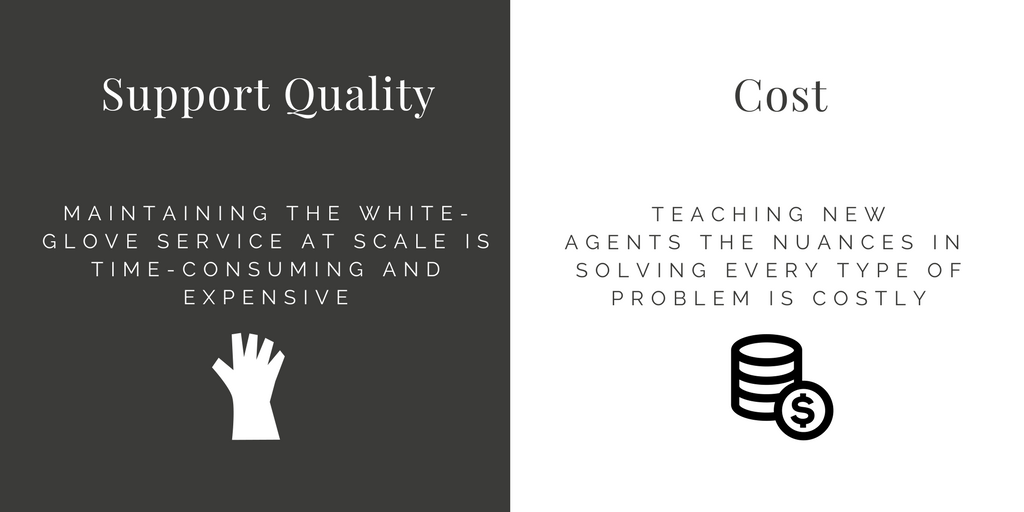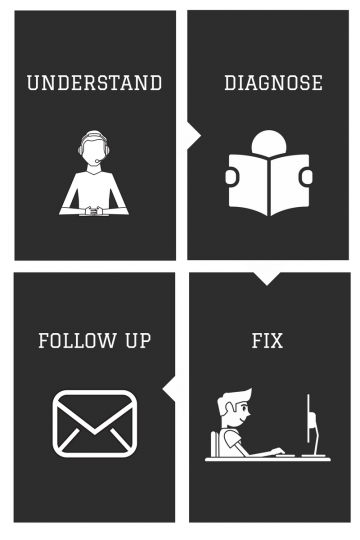As your business grows, there will inevitably be some bumps in the road. You’re guaranteed to encounter an angry customer or two, customer service reps who struggle to deliver quality support, ever-changing customer service processes, and more.
With the right approach, and armed with the right information, you’ll be able to overcome any challenge to successfully scale customer support, grow your business, and generate a great deal of customer loyalty.
In this article, I’ll share my personal experience with scaling a customer support team from the ground up, common challenges, tips for scaling at each stage of growth, and more.
Let’s get started.
- What is Scalable Support?
- My Experience with Customer Service (From Scratch)
- Getting to the Root of the Problem
- The Process of Support
- What Customer Service Model Really Works?
- The Key to Scaling Customer Support
- The Different Stages of Scaling Customer Support
- How Do You Grow a Support Team?
- Scale Your Customer Support
Contents
- What is Scalable Support?
- My Experience with Customer Service (From Scratch)
- Getting to the Root of the Problem
- The Process of Support
- So, What Customer Service Model Really Works?
- The Key to Scaling Customer Support
- Sign me up
- The Different Stages of Scaling Customer Support
- How Do You Grow a Customer Support Team?
- Scale Customer Support with Idiomatic
What is Scalable Support?
Scalable support is a customer service team that is capable of growing in a way that supports the growth of your business. Scalable support teams are flexible, malleable, and efficient. They’re able to expand without compromising on service quality.
My Experience with Customer Service (From Scratch)
Before starting Idiomatic, I founded EAT Club, now the country’s largest online corporate lunch delivery company. In our first year, I personally fielded every customer service email and call, showering each customer with attention.
Along the way, I got to know hundreds of our early customers. I learned their names, where they worked, and their favorite meals. Importantly, I learned what they loved and hated about our experience, allowing my co-founder and me to focus on fixing the largest pain points.
Our happy customers spread the word, and the business grew. But, we quickly learned that my original strategy “do whatever it takes” doesn’t scale for large customer support teams. The dual challenges we faced were maintaining high support quality while controlling costs.
👉 Learn more: 13 customer service KPIs: Your guide to performance metrics

These are growing pains that any service organization scaling from 5 to 50 to 500 agents has to overcome. Progress on one often comes at the detriment of the other. At Idiomatic, we work with great customer support organizations that have managed to simultaneously raise service quality and cut costs. The secret is to constantly improve by learning from customer interactions. After all, the best way of managing customer support costs is for customers to not have problems in the first place.
Getting to the Root of the Problem
As wonderful as your customer support agents are, your happiest customers are the ones that never have to talk to you. The best customer experiences just work with no unnecessary friction.
While no product or service is perfect, leading companies continuously monitor top contact reasons and complaints. Their product and operations teams actively work to fix the root causes of customer complaints, and when they’re successful, those types of complaints disappear. Over time, iterating on this process results in a refreshingly smooth customer experience, low contact rates, and high customer satisfaction scores.
To identify and quantify top customer pain points, companies tag support tickets with granular user issues. To start, they do this in-house, but a technological solution like Idiomatic can be very helpful at scale. My co-founder Chris recently wrote an excellent primer on ticket tagging best practices.
Whenever I call my cable company, the agent always asks me to unplug my device, wait 10 seconds, and plug it back in, even when it’s obvious that won’t fix my problem. This is infuriating because it feels like the agent wasn’t even listening to me and was just blindly following a checklist. Many modern companies try to avoid this trap by asking agents to use their best judgment.
The customization strategy is fine early on but breaks down at scale; depending on which support agent handles the customer’s case, wildly different outcomes can occur. This inconsistency is bad for the customer and stressful for the agent, who needs a smart playbook that fits the specific customer problem.
The Process of Support
Training a team to provide consistent service is hard. Each time a new support case opens, four things need to happen called the Process of Support:

Here’s how it works:
- The agent reads the ticket to understand what the customer is experiencing.
- The agent diagnoses the actual problem by checking internal systems or soliciting more information from the customer.
- The agent chooses and implements the solution.
- The agent closes the loop with the customer.
For an inexperienced agent at a complicated business, there is ample room for error in this flow. The agent could misinterpret the problem, misdiagnose the root cause, or choose a poor solution—all of which leads to longer resolution times, frustrating the customer and costing the business time and money.
This means this old-school process is not the most effective method for scaling customer support or providing great customer service.
So, What Customer Service Model Really Works?
The customer service operation model that we’ve seen consistently deliver great service at scale works the following way: new support cases are rapidly classified and routed to an appropriately experienced agent along with a playbook for diagnosing and solving that specific user issue. That playbook is drawn from prior cases dealing with the same specific user issue that resulted in high customer satisfaction. This way, the agent can confidently speed through the diagnosis and solution steps and focus on having empathetic interactions with the customer.
Putting this model in place requires substantial data engineering, human case routing, and knowledge base management that makes it seem like a distant holy grail for most customer service organizations. That’s why here at Idiomatic, we’ve built artificial intelligence technology that understands the customer’s problems to streamline the deployment of this model.
The Key to Scaling Customer Support
To recap, listening to customers is key to scaling a customer service organization because it offers you two key abilities:
- Fixing the root causes of why customers contact support in the first place is both cost-effective and creates a better customer experience.
- For the remaining issues, arm your agents with a smart playbook that streamlines issue diagnosis and solution.
Create magical experiences with your product or service. Sign up for our newsletter (at the end of our homepage) to get expert advice straight to your inbox.
Sign me up
The Different Stages of Scaling Customer Support
Let me walk you through the different stages of scaling customer service and what to do in each stage in order to scale without compromising quality.
Founding stage (0 – 5 employees)
This stage is essentially not applicable to scaling customer support as you, the owner, is likely the support person (or at the very least someone else on your team also wears this hat along with their usual, unrelated role). At this stage, don’t worry about scaling your customer service just yet.
Early stage (5 – 20 employees)
At this stage, you should have one person whose role is dedicated to customer service. Since you’re still in the early stage, this person may not necessarily be a full-time employee, but their job should be solely focused on helping your customers.
How you scale at this early stage:
- Set up and define a clear communication channel to connect your customers and your customer service representative. (I recommended a shared email address where multiple people can check in if necessary.)
- Set up a post-interaction rating system (e.g. NPS) to get a sense of customer satisfaction and predicted loyalty.
- Create email templates to answer common questions.
- Start tracking the volume of tickets/requests.
- Start writing helpful content for your customers (e.g. How to use XYZ section of our product or create an FAQ page on your website).
Mid-stage (20-100 employees)
At this stage, you should have a second employee whose role is also entirely dedicated to customer service. This stage is where you want to focus on processes and documentation to really fine-tune your operations.
How you scale at this mid-stage:
- Go beyond the basic measurements you were taking during the early stage and start tracking things like response and resolution time.
- Go beyond the support email and open up new support channels. Add a phone number and even consider a LiveChat function on your website. (Be sure to implement a post-interaction measurement tool across multiple channels to track customer satisfaction).
- Look for more opportunities to create education-based support on the most common issues you’ve seen so far. Since you’ve already started writing helpful blogs in the previous stage, this stage could go a step further and include content such as e-books, podcasts, weekly emails, case studies, webinars, and video tutorials.
Growth stage (100 – 250 employees)
At this stage, you’ll likely need to split your customer support team into two customer support teams. One as a reactive customer support team and the other as a customer success team. The reactive customer support team will be similar to the majority of what you’ve dealt with in the past (putting out fires and addressing concerns as they arise). The customer success team will be responsible for the proactive work of customer retention.
How you scale at this growth stage:
- Hire a VP of Customer Success or Chief Customer Officer. This could be an internal hire (with the right person, of course), someone who comes highly recommended to you by your investors, board, or headhunters, or an external hire outside of your network.
- Give your customer service team target metrics to help demonstrate their value to the company (e.g. net revenue and churn).
- Use your customer contact and feedback data to start creating predictive power of models to determine which customer service approach would help boost revenue.
- Pick a specialized customer service system or tool that works best for your needs.
Scale-up Stage (250+ employees)
At this stage, specialized teams will want to aim for a ratio of 8:1 when it comes to individual contributors and managers. For less specialized teams 15:1 or even 20:1 is appropriate.
How you scale at this scale-up stage:
- Use your customer contact and feedback data to generate more accurate forecasting.
- Implement performance tracking at the individual rep level by measuring customer service interaction metrics such as ticket volume and close times.
- Have team leads take on the bulk of the mentoring, coaching, and quality assurance.
How Do You Grow a Customer Support Team?
There are many important steps to growing a support team but some of the most important ones include hiring the right people, empowering the customer support team, prioritizing the right customers, creating opportunities for customers to easily find answers themselves, maintaining a people over process approach, and embracing automation.
Scale Customer Support with Idiomatic
Since the key to scaling customer support is listening to your customers and empowering your CS team, you’re going to want to implement the right tools to keep up with (and assist) with your growth. Idiomatic’s AI-driven customer satisfaction software allows you to easily process large volumes of customer feedback data, and optimize support operations by truly understanding customer pain points, which results in saving your CS team time and making them feel more confident about their work.
Request a demo to learn more about our powerful software that can take your customer support to the next level at every stage.
Reduce costs by scaling your customer support operations the right way. Here’s how Idiomatic can help.




